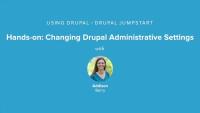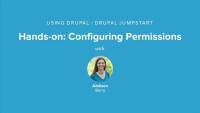This page is archived
We're keeping this page up as a courtesy to folks who may need to refer to old instructions. We don't plan to update this page.
Alternate resources
This series, from the O'Reilly Media book Using Drupal, Second Edition, is intended for people who are new to Drupal, provides a tour of its capabilities, as well as definitions for its sometimes obscure terminology. We’ll demonstrate how Drupal can be used “out of the box” to build a simple website. Readers who are familiar with Drupal already may still want to skim through this, as later series in the Using Drupal guide will assume knowledge of all content covered here. By the end, you’ll understand how to perform administrative tasks in Drupal, such as configuring modules, working with content types, and setting up site navigation. This series assumes that you already have Drupal up and running. For assistance with that, check out the Appendix A series, on Installing and Updating Drupal, as well as the helpful Drupal.org Getting Started guide.
See our guide Using Drupal Book by O'Reilly Media to access all of our tutorials related to this book. Each series covers a chapter (or appendix).
This series, from the O'Reilly Media book Using Drupal, Second Edition, is intended for people who are new to Drupal, provides a tour of its capabilities, as well as definitions for its sometimes obscure terminology. We’ll demonstrate how Drupal can be used “out of the box” to build a simple website. Readers who are familiar with Drupal already may still want to skim through this, as later series in the Using Drupal guide will assume knowledge of all content covered here. By the end, you’ll understand how to perform administrative tasks in Drupal, such as configuring modules, working with content types, and setting up site navigation. This series assumes that you already have Drupal up and running. For assistance with that, check out the Appendix A series, on Installing and Updating Drupal, as well as the helpful Drupal.org Getting Started guide.
To get things started with Drupal, we're going to build out a very basic website. The Mom & Pop, Inc. site project will cover many of the basic pieces you need to grasp the fundamentals of building with Drupal, and are a good foundation for the other series we'll be doing from Using Drupal. We'll take a tour through the administrative settings, create and manage content, work with modules and users, as well as changing the look of our new site. In this first lesson in the series we're going to review the Mom & Pop case study and discuss our implementation plan.
Additional resources
In this lesson we're going to start off with the Drupal administrative interface. We'll take a tour of the major elements and get you oriented to what is where.
Additional resources
For this lesson we're going to get hands-on and play around in our administration area a little. We're going to review the site information for our new site, and then change things by setting the site name to match our case study.
Additional resources
This lesson offers a tour of some of the most basic tools for content management in Drupal. We're going to walk through and explain the following pieces:
- Content
- Comments
- Navigation
- Blocks
Additional resources
In this lesson we're going to start building our site for Mom and Pop, Inc. We're starting off by working on our content, to get things filled out a little. First, we'll create an About Us page with the basic info for the store, like address and opening hours. Then we'll create our first article, which welcomes people to the new site, and see how the two core content types, Basic page and Article, are different from each other. Then we'll tweak our main navigation so our tabs display correctly, and finish things off by looking at block management. We'll remove the "Powered by Drupal" block and add a new block to the site for our weekly specials.
Additional resources
Modules allow you to turn on and off functionality within your Drupal website. There are two types of modules: core modules, which come with Drupal itself, and contributed modules, which are provided for free by the Drupal community and available for download from Drupal.org. In this lesson we're going to look at the module administration page, and walk through finding and installing modules. We'll wrap things up by discussing how you remove a module from your site, and the difference between disabling and uninstalling.
Additional resources
The easiest way to wrap your head around how modules work is to try installing and configuring a couple of them. This section will cover how to install, enable, and configure a contributed module called Using Drupal, 2nd edition
One of the most powerful features of Drupal is its rich, fine-grained access control system, based around the concept of users, roles, and permissions. In this lesson we'll explain what these pieces are, and how they work together. We'll also discuss the user profile and various user account settings we can manipulate.
Additional resources
For our Mom and Pop site, we're going to need to sort out how to set up access control for our users. In this lesson we'll review our users and their access needs, check and create the roles we need, and then create users.
Additional resources
With roles and users in place on the site, we have a good start, but we aren't actually controlling access very well until we set up the permissions to go with those. In this lesson we need to set permissions for our roles, and take a look at some important security concerns around permissions. Finally, we'll test our access control by logging in as our users to make sure everything is acting as it should.
Additional resources
When you open the floodgates for your users to become active participants in content creation, one of the inevitable things that comes up is the issue of content moderation—that is, ensuring that abusive, vulgar content and unsolicited advertising or spam is kept off the site and stays off. In this lesson, we'll look at using an automated spam detection, with Mollom, as well as manual spam prevention.
Additional resources
Drupalize.Me Guide: Using Drupal Book by O'Reilly Media
Note: Mollom is EOL (End Of Life). See this blog post by Drupal community member Jeff Geerling for alternative solutions.
Let’s tie together everything we’ve learned so far and get a contact form added to our site. This will involve enabling the core Contact module, configuring its settings, and adding permissions.
Additional resources
Drupal gives you a lot of tools to move things around and arrange the functionality of your site, but often the main difference between most websites comes down to presentation. Themes are the Drupal method for controlling your site’s presentation. In this lesson we'll discuss finding a theme, and installing and configuring themes. A big part of understanding how themes can change your layout lies in understanding blocks and regions, so we'll cover what those are, and why they're important. Then we'll talk briefly about administration themes and how they are different from your main theme.
Additional resources
Now it’s time to make the site look less like Drupal and more like Mom and Pop, Inc. In this lesson we'll modify the core Bartik theme by changing the site logo and the color scheme to match what we need for our project.
Additional resources
In this series we've provided an overview of Drupal’s major functionality by walking you through building a small website, Mom and Pop, Inc. To wrap things up we're going to take a tour of the new Mom & Pop, Inc, website, and discuss our implementation points as we walk through it. Then we'll review the modules and resources we've discussed in this series.
Additional resources
Drupalize.Me Guide: Using Drupal Book by O'Reilly Media
Up next: Using Drupal Chapter 3: Job Board














